Conflicting Maps: How Legal Perspectives Could Minimize Zoning Cancellation in Republic of Korea
Abstract
1. Introduction
2. Literature Review
2.1. Property Rights, Zoning from an International Perspective, and Maps
2.1.1. Property Rights—International Context
| Category | Korea | US | France | UK | Germany | Japan |
|---|---|---|---|---|---|---|
| Applicable laws |
|
|
|
|
|
|
| Disposition |
|
|
|
|
|
|
| Type of map |
|
|
|
|
|
|
2.1.2. Maps—Evolvement and Current Situation in Republic of Korea
2.2. FARLU and LURM
2.2.1. FARLU
2.2.2. LURM
2.2.3. LURM Announcement Process according to the FARLU
3. Research Scope and Methodology
4. Causes of Zoning Cancellation Identified through LURM Cases and the Literature
4.1. Discordance of the LURM May Represent an Infringement on Property Rights. Why Is the Incorrect Serial Cadastral Map Still Being Used When Cadastral Computerized Data Are Available?
4.1.1. Infringement on Property Rights According to Case Studies
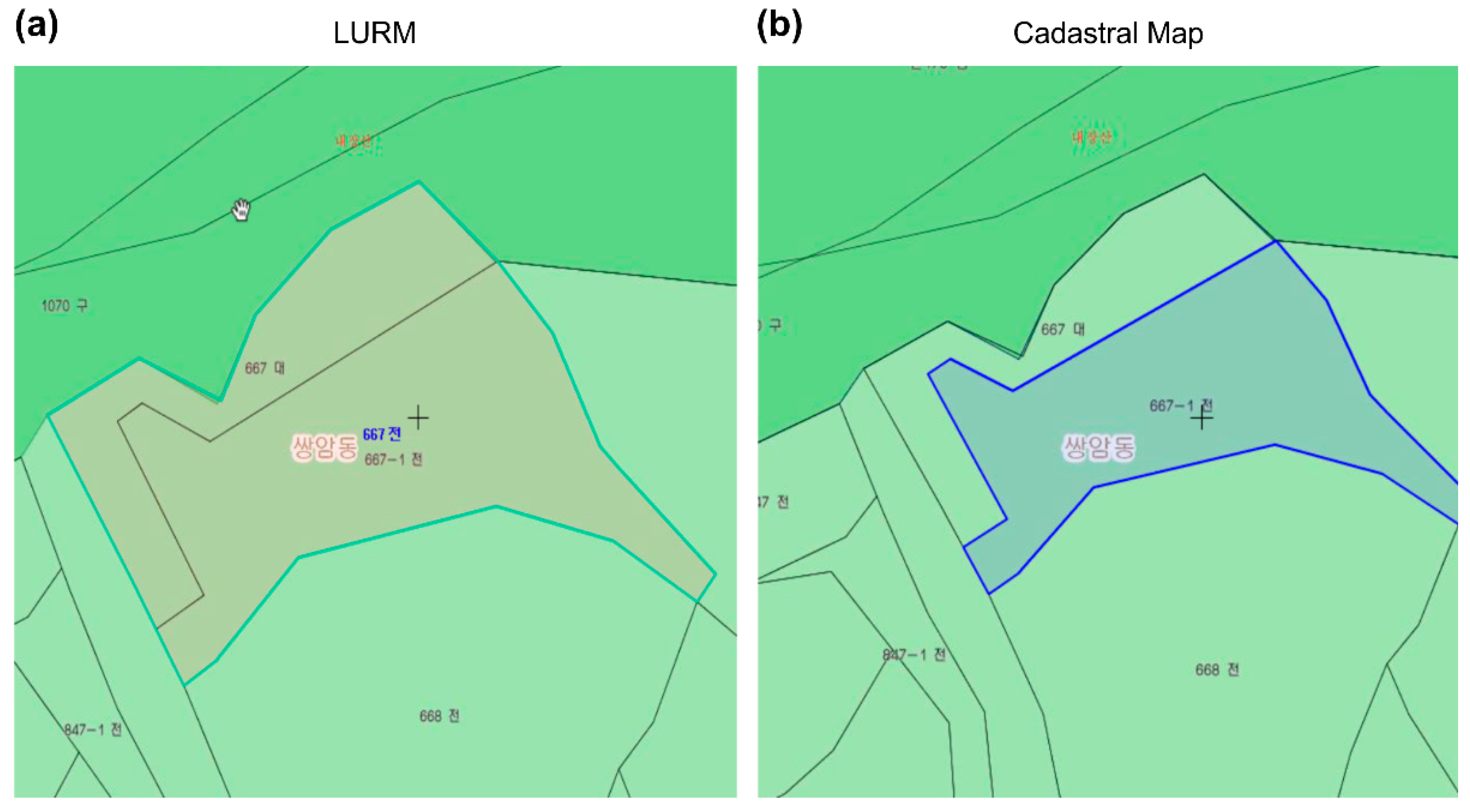
4.1.2. Incorrect Data (Serial Cadastral Map) Is Applied to the LURM
4.1.3. Use of Cadastral Computerized Data, Including Cadastral Maps and Digital Cadastral Paps, Is Restricted
4.2. Inappropriate Application of the Tolerance of a Cadastral Map to the LURM
4.3. The Digital Cadastral Map Preparation Speed Required for the LURM Is Slow
5. Proposals from a Legal Perspective Needed for LURM Enhancement to Minimize Zoning Cancellation
5.1. Make the Cadastral Computerized Data Public and Apply It to the LURM While Stopping the Use of Serial Cadastral Maps
5.2. Demonstrate the Justification for Introducing the Tolerance of the LURM from a Legal Perspective
5.3. Introduce Legal Fiction for the Digital Cadastral Map to Achieve Timelier Preparation of the Digital Cadastral Map Needed for the LURM (Fast Track)
6. Discussion and Conclusions
Author Contributions
Funding
Data Availability Statement
Acknowledgments
Conflicts of Interest
References
- Balchin, W.G.V. The development of land use maps. Land Use Policy 1985, 2, 3–15. [Google Scholar] [CrossRef]
- Andrews, T. Official maps and the regulatory takings problem: A legislative solution. Brigh. Young Univ. Law Rev. 2011, 6, 2251. [Google Scholar]
- Supreme Court 2020 ECLI:FR: 436549. Regarding whether the commune map has a legal effect even after the ELAN legislation (9 January 2019), Administrative Court(Poitier), the French Republic.
- Supreme Court 2020 ECLI:FR: 437590. Regarding the cancellation of Korea’s urban plan (including land use) reflected in the commune map due to an act of arrogation, Administrative Court(De Grenoble), the French Republic.
- National Law Information Center. Available online: www.law.go.kr/engLsSc.do?menuId=1&subMenuId=21&tabMenuId=117&query=%ED%86%A0%EC%A7%80%EC%9D%B4%EC%9A%A9%EA%B7%9C%EC%A0%9C%EA%B8%B0%EB%B3%B8%EB%B2%95# (accessed on 20 February 2021).
- Ministry of Land Infrastructure and Transport (Sejong-si, Korea). A Comparison of Land Use Regulation Maps and Cadastral Maps. Personal communication, 2018. [Google Scholar]
- Cobb, M.A.; Chung, M.J.; Foley III, H.; Petry, F.E.; Shaw, K.B.; Miller, H.V. A rule-based approach for the conflation of attributed vector data. GeoInformatica 1998, 2, 7–35. [Google Scholar] [CrossRef]
- Doytsher, Y.; Filin, S.; Ezra, E. Transformation of datasets in a linear-based map conflation framework. Surv. Land Inf. Syst. 2001, 61, 165–176. [Google Scholar]
- Chen, C.-C.; Knoblock, C.A.; Shahabi, C. Automatically conflating road vector data with orthoimagery. GeoInformatica 2006, 10, 495–530. [Google Scholar] [CrossRef]
- Kim, S.-M.; Han, S.-H.; Heo, J. Comparing the survey package of land administration domain model with the cadastral information model in Korea. J. Korean Soc. Geospat. Inf. Syst. 2009, 17, 113–119. [Google Scholar]
- Shin, G.M. The legal issue on cadastral inconsistency land. J. KCIA 2014, 16, 81–93. [Google Scholar]
- Korea Ministry of Government Legislation. The Establishment Management of Spatial Data Act, Article 2 (Definitions); Korea Ministry of Government Legislation: Sejong-si, Korea, 2015.
- Ben, C.; Gounder, N. Property rights: Principles of customary land and urban development in Fiji. Land Use Policy 2019, 87, 104089. [Google Scholar] [CrossRef]
- Castro, K.B.D.; Roig, H.L.; Neumann, M.R.B.; Rossi, M.S.; Seraphim, A.P.A.C.C.; Réquia, W.J.; Costa, A.B.B.D.; Höfer, R. New perspectives in land use mapping based on urban morphology: A case study of the Federal District, Brazil. Land Use Policy 2019, 87, 104032. [Google Scholar] [CrossRef]
- Lees, M.A. Preserving property values—Preserving proper homes—Preserving privilege: The pre-euclid debate over zoning for exclusively private residential areas, 1916–1926. Univ. Pittsburgh Law Rev. 1994, 56, 367. [Google Scholar]
- Stanfield, B.J.; Bliss, J.C.; Spies, T.A. Land ownership and landscape structure: A spatial analysis of sixty-six Oregon (USA) Coast Range watersheds. Landsc. Ecol. 2002, 17, 685–697. [Google Scholar] [CrossRef]
- Blomley, N. Law, property, and the geography of violence: The frontier, the survey, and the grid. Annals Assoc. Am. Geogr. 2003, 93, 121–141. [Google Scholar] [CrossRef]
- Fischel, W.A. Zoning and land use regulation. Encycl. Law Econ. 2000, 2, 403–423. [Google Scholar]
- Gallent, N.; Kim, K.S. Land zoning and local discretion in the Korean planning system. Land Use Policy 2001, 18, 233–243. [Google Scholar] [CrossRef]
- Moon, J.K.; Sohn, H.-G.; Kim, S.; Hong, S.H.; Cho, Y.S. Using law enforcing thematic maps for public announcements in South Korea. KSCE J. Civ. Eng. 2018, 22, 794–803. [Google Scholar] [CrossRef]
- Vandevelde, K.J. New property of the nineteenth century: The development of the modern concept of property. Buff. Law Rev. 1980, 29, 325–368. [Google Scholar]
- Constitutional Court 1987. Available online: http://www.law.go.kr/lsInfoP.do?lsiSeq=61603&efYd=19880225#0000 (accessed on 18 May 2020).
- The National Assembly Research Service 2017 (Seoul, Korea). Property Rights and Land Use Regulations. Personal communication, 2017. [Google Scholar]
- Song, D.-S. Rechtsnatur der behördlichen Bekanntgaben (Gosi) und Rechtsschutz. Public Land Law Rev. 2011, 52, 239–267. [Google Scholar]
- Seok, H.-Y. A Legal Study on the Use of Air Space. Ph.D. Thesis, Department of Law Korea University Graduate School, Seoul, Korea, 2017. [Google Scholar]
- The National Assembly Research Service 2017 (Seoul, Korea). Property Rights and Administrative Act. Personal communication, 2017. [Google Scholar]
- The National Assembly Research Service 2018 (Seoul, Korea). Property Rights and Administrative Disposition. Personal communication, 2018. [Google Scholar]
- Joo, J. The comparative study on the U.S. adverse possession doctrine. Kangwon Law Rev. 2012, 35, 387–424. [Google Scholar]
- Kim, Y. Discrimination of private property right protection in the U.S. urban regeneration projects: A perspective of legal geography. J. Korean Geogr. Soc. 2012, 47, 245–267. [Google Scholar]
- HM Land Registry. HM Land Registry Plans: The Basis of Land Registry Plans (Practice Guide 40, Supplement 1). 2016. Available online: https://www.gov.uk/government/publications/land-registry-plans-the-basis-of-land-registry-applications/land-registry-plans-the-basis-of-land-registry-plans-practice-guide-40-supplement-1 (accessed on 3 January 2020).
- Collectivités Locales. Un Apport Dans la Mise en Place de Systèmes d’information Géographiques, SIG. 2017. Available online: https://www.collectivites-locales.gouv.fr/apport-dans-mise-place-systemes-dinformation-geographiques-sig (accessed on 11 January 2020).
- Institut National de l’Information Géographique et Forestière. Cartographie. 2017. Available online: http://www.ign.fr/institut/activites/cartographie (accessed on 29 December 2017).
- U.S. Act, Standard State Zoning Enabling (SZEA). Available online: https://www.planning.org/growingsmart/enablingacts/ (accessed on 20 April 2020).
- France. Land Orientation Law. Available online: https://www.legifrance.gouv.fr/affichCode.do?cidTexte=LEGITEXT000006070721 (accessed on 20 April 2020).
- U.K Planning and Compensation Law. Available online: http://www.legislation.gov.uk/ukpga/1991/34/contents (accessed on 20 April 2020).
- Germany. Regional Planning Act. Available online: http://www.gesetze-im-internet.de/bbaug/ (accessed on 20 April 2020).
- Japan. Available online: https://xn--eckucmux0ukcy120betvc.com/s49sei387/ (accessed on 20 April 2020).
- Fox, J. Mapping the commons: The social context of spatial information technologies. Common Prop. Resour. Digest 1998, 45, 1–4. [Google Scholar]
- Eck, J.; Chainey, S.; Cameron, J.; Wilson, R. Mapping Crime: Understanding Hotspots (Report. G-91); Police Department (U.S.): Washington, CA, USA, 2005. Available online: https://nij.ojp.gov/library/publications/mapping-crime-understanding-hot-spots (accessed on 20 April 2020).
- Di Lisio, A.; Russo, F. Thematic maps for land-use planning and policy decisions in the Calaggio stream catchment area. J. Maps 2010, 6, 68–83. [Google Scholar] [CrossRef]
- McCloskey, M.J. Visualizing the law: Methods for mapping the legal landscape and drawing analogies. Wash. L. Rev. 1998, 73, 163–192. [Google Scholar]
- Weiss, M.J. Maps as a decision-support tool in rail transport policy formulation in UK. J. Maps 2010, 6, 211–219. [Google Scholar]
- Huh, Y.; Yang, S.; Ga, C.; Yu, K.; Shi, W. Line segment confidence region-based string matching method for map conflation. ISPRS J. Photogramm. Remote Sens. 2013, 78, 69–84. [Google Scholar] [CrossRef]
- Kao, S.; Tu, C.; Chen, C. A coordinate vector correction method to improve the traditional affine transformation graphic digitised cadastral map. Surv. Rev. 2013, 45, 352–356. [Google Scholar] [CrossRef]
- Hong, S.-E. The modification of serial cadastral map and its applications to notification of topographical maps. J. Korea Acad. Ind. Coop. Soc. 2011, 12, 4826–4834. [Google Scholar]
- Hong Sung, E. A method for surveying cadastral non-coincidency using digital cadastral maps and digital topographic maps. J. Korean Cadastre Inf. Assoc. 2004, 17, 307–313. [Google Scholar]
- Lee, J. A Study on the Modern Interpretation of Land-Use Right; Department of Law, Graduate School, Dong Eui University: Pusan, Korea, 2012; pp. 1–182. [Google Scholar]
- Moon, J.; Kwon, H.Y.; Cho, H.S.; Sohn, H.G. Improvement of public announcement of topographic drawing for linear-type infrastructure. J. Korean Soc. Civ. Eng. 2014, 34, 1327–1334. [Google Scholar] [CrossRef]
- National Land Information Corporation (LX). A Study on Reorganized Plan of the Management System of the Continuous Cadastral Map; L. R. Institute: LX, Korea, 2015; pp. 1–182. [Google Scholar]
- Korea Ministry of Government Legislation. 2017. Available online: http://www.law.go.kr/engLsSc.do?tabMenuId=tab45&query=%EA%B3%B5%EA%B0%84%EC%A0%95%EB%B3%B4# (accessed on 18 May 2020).
- Cerba, O.; Cepicky, J. Web services for thematic maps. In Online Maps with APIs and Webservices; Springer: Berlin/Heidelberg, Germany, 2012; pp. 141–155. [Google Scholar]
- Braverman, I.; Blomley, N.; Delaney, D.; Kedar, A. The Expanding Spaces of Law: A Timely Legal Geography; Stanford University Press: Stanford, CA, USA, 2014. [Google Scholar]
- Carr, J. The expanding spaces of law: A timely legal geography. Geogr. Rev. 2015, 50, 268–271. [Google Scholar] [CrossRef]
- Rodgers, C. Property rights, land use and the rural environment: A case for reform. Land Use Policy 2009, 26, S134–S141. [Google Scholar] [CrossRef]
- Gillespie, J. A legal geography of property, tenure, exclusion, and rights in Cambodia: Exposing an incongruous property narrative for non-Western settings. Geogr. Res. 2016, 54, 256–266. [Google Scholar] [CrossRef]
- Park, S. An Economic Analysis on the Land Use Regulation and Compensation: Focusing the System of Purchase Claim Rights. Ph.D. Thesis, Soongsil University, Soongsil, Korea, 2009. [Google Scholar]
- Ryu, C. A Legislative Study on Perpendicular Scope of Land Ownership; Korea Legislation Research Institute: Seoul, Korea, 2005. [Google Scholar]
- Song, J.I. De l’objet de la propriétéimmobilièreen droit coréen et français: Volumétrie et superficie. Ajou Law 2014, 7, 263–315. [Google Scholar] [CrossRef]
- Cheung, Y. The Current State and Improvement Measures of Public Announcement of Topographical Drawing through Keyword Analysis with a Focus on the Public Announcement of Road Zones. Master’s Thesis, University of Seoul, Seoul, Korea, 2017. [Google Scholar]
- Lee, J. A study on the using and control of Korea Land. Public Land Law Rev. 2010, 50, 93–125. [Google Scholar]
- Supreme Court 2007 Du 12063. Decision of City Planning Facility and Cancellation of Approval of Topographical Drawing; Supreme Court of Korea: Seoul, Korea, 2007. [Google Scholar]
- Supreme Court 92 NU 5607. Nullification of Notification of Urban Plan Line Topographic Map; Supreme Court of Korea: Seoul, Korea, 1993. [Google Scholar]
- Medema, S.G. Symposium on the coase theorem: Legal fiction: The place of the coase theorem in law and economics. Econ. Philos. 1999, 15, 209–233. [Google Scholar] [CrossRef]
- Woo-Hyung, C. A comparative study on the cadastral and the land registration of land survey projects in Korea. J. Korean Cadastre Inf. Assoc. 2010, 12, 157–172. [Google Scholar]
- Kim, K.T. An Analysis of Cadastral Topographic Control Points Surveying by Traverse Method. Master’s Thesis, University of Seoul, Seoul, Korea, 2013. [Google Scholar]
- Gwak, I.S.; Chae, H.S.; Kim, J.H.; Jeong, G.T. Inspection on cadastral resurvey results by digital photogrammetry systems. J. Korean Cadastre Inf. Assoc. 2014, 16, 173–183. [Google Scholar]
- Constitutional Court. Civil Act Article 211; Korea Ministry of Government Legislation: Sejong, Korea, 2017. [Google Scholar]
- Gangwon-do Office of Education (Bongrae Middle School, Goheung-gun, Korea). Personal communication, 1981.
- Seoul Metropolitan Government (University of Seoul Metropolitan, Seoul, Korea). Personal communication, 2017.
- Supreme Court 95 NU 13920. Judgment on Revocation of Refusal Disposition for Alteration of Land Shape and Quality; Supreme Court of Korea: Seoul, Korea, 1996. [Google Scholar]
- Supreme Court 2012 Da 87898. Precedents Relating to the Limit in Using Digital Cadastral Data; Supreme Court of Korea: Seoul, Korea, 2016. [Google Scholar]
- Crowell, M.; Leatherman, S.P.; Buckley, M.K. Historical shoreline change: Error analysis and mapping accuracy. J. Coast. Res. 1991, 7, 839–852. [Google Scholar]
- Kim, T.H. The principle of proportionality under administrative law—With emphasis on the precedents of the Supreme Court of Korea. Public Law Res. 2009, 37, 89–116. [Google Scholar]
- Ministry of Land Infrastructure and Transport (Sejong-si, Korea). Land Use Regulation Information System. Personal communication, 2019. [Google Scholar]
- Korea Research Institute for Human Settlements. Working-level training for local government employees of the Land Use Regulatory Information System (LURIS). Plan. Policy 2008, 326, 158–159. [Google Scholar]
- Kim, S.-G. Based on the public concept of land ownership, examination of the range of underground to airspace of land ownership. Legal Res. 2018, 57, 59–82. [Google Scholar]
- Kim, J.; Cho, K.; Kim, T.; Yoon, Y. Predicting the monetary value of office property post renovation work. J. Urban Plan. Dev. 2018, 144, 04018007. [Google Scholar] [CrossRef]
- Park, C. A Critical Study on Proportionality Principle in the Interpretation of the Constitutional Law. Master’s Thesis, Yonsei University, Seoul, Korea, 2005. [Google Scholar]
- Jung, Y.-H. The unconstitutional review on the legislative discretion in constitutional adjudication. Hongik Law Rev. 2013, 14, 697–736. [Google Scholar] [CrossRef]
- Hong, S.H. The legal nature of the social rights and the legislative discretion—With a comparative perspective on the discussion in U.S. Study Am. Const. 2017, 28, 261–295. [Google Scholar]
- Lee, B. Verfassungsvorbehalt und Gesetzesvorbehalt. Const. Res. 2008, 36, 201–224. [Google Scholar]
- Division of Urban Planning in Jeongeup-City, Chonbuk Provincial Government (Jeongeup, Korea). Personal communication, 2017.
- Jang, H.S. A study on the efficient notification of topographical maps by using cadastral information -focused on the road and adjoining zone. J. Real Estate Law Res. 2010, 16, 137–152. [Google Scholar]
- Seok, H.-Y.; Shin, B.-K. Rechtliche Argumente zur Einführung des Flächenzertifikatehandels in Deutschland. Public Land Law Rev. 2017, 79, 247–271. [Google Scholar]
- Lee, J.-W. A Study on the Information Disclosure of Local Governments; Seoul National University: Seoul, Korea, 2013. [Google Scholar]
- Walker, D. Debate: Government’s right to know. Public Money Manag. 2016, 36, 392–394. [Google Scholar] [CrossRef]
- Greulich, G.; Valentine, W.H.; Chamard, R. Quality in constructed project: Surveying engineering. J. Surv. Eng. 1994, 120, 52–61. [Google Scholar] [CrossRef]
- Navratil, G. Modeling data quality with possibility-distributions. Qual. Asp. Spatial Data Min. 2009, 91. Available online: https://scholar.google.co.kr/scholar?as_vis=1&q=Modeling+Data+Quality+with+Possibility+Distributions&hl=ko&as_sdt=0,5 (accessed on 23 February 2021).
- Chimhamhiwa, D.; Mutanga, O.; van der Molen, P. Measuring quality performance of cadastral survey and deeds registration work processes. Land Use Policy 2011, 28, 38–46. [Google Scholar] [CrossRef]
- Park, W.C. Implementation of Cadastral Results Determine System for Position Accuracy Improvement. Ph.D. Thesis, University of Myoung Ji, Seoul, Korea, 2011. [Google Scholar]
- Zhu, C.; Shi, W.; Li, Q.; Wang, G.; Cheung, T.; Dai, E.; Shea, G. Estimation of average DEM accuracy under linear interpolation considering random error at the nodes of TIN model. Int. J. Remote Sens. 2005, 26, 5509–5523. [Google Scholar] [CrossRef]
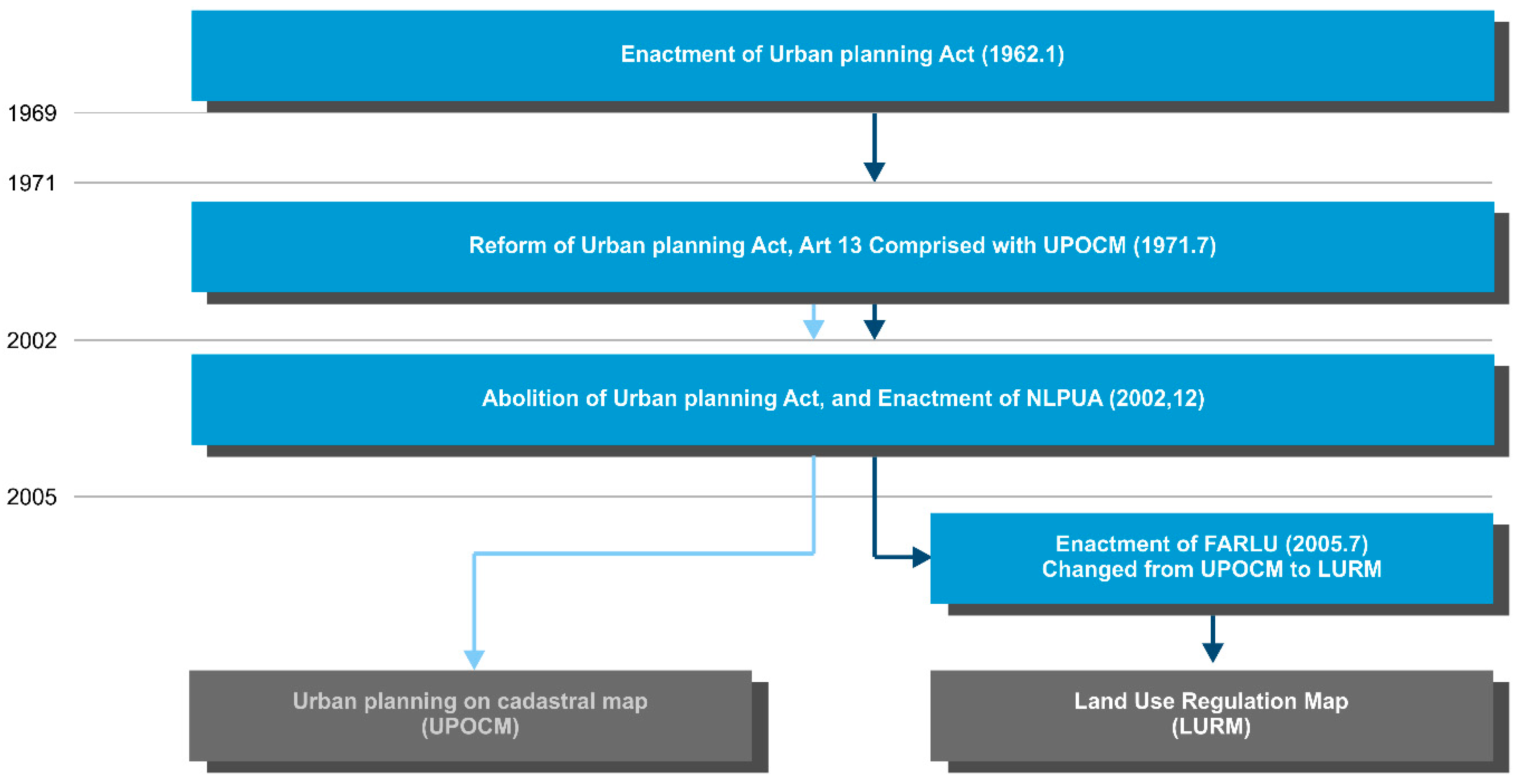
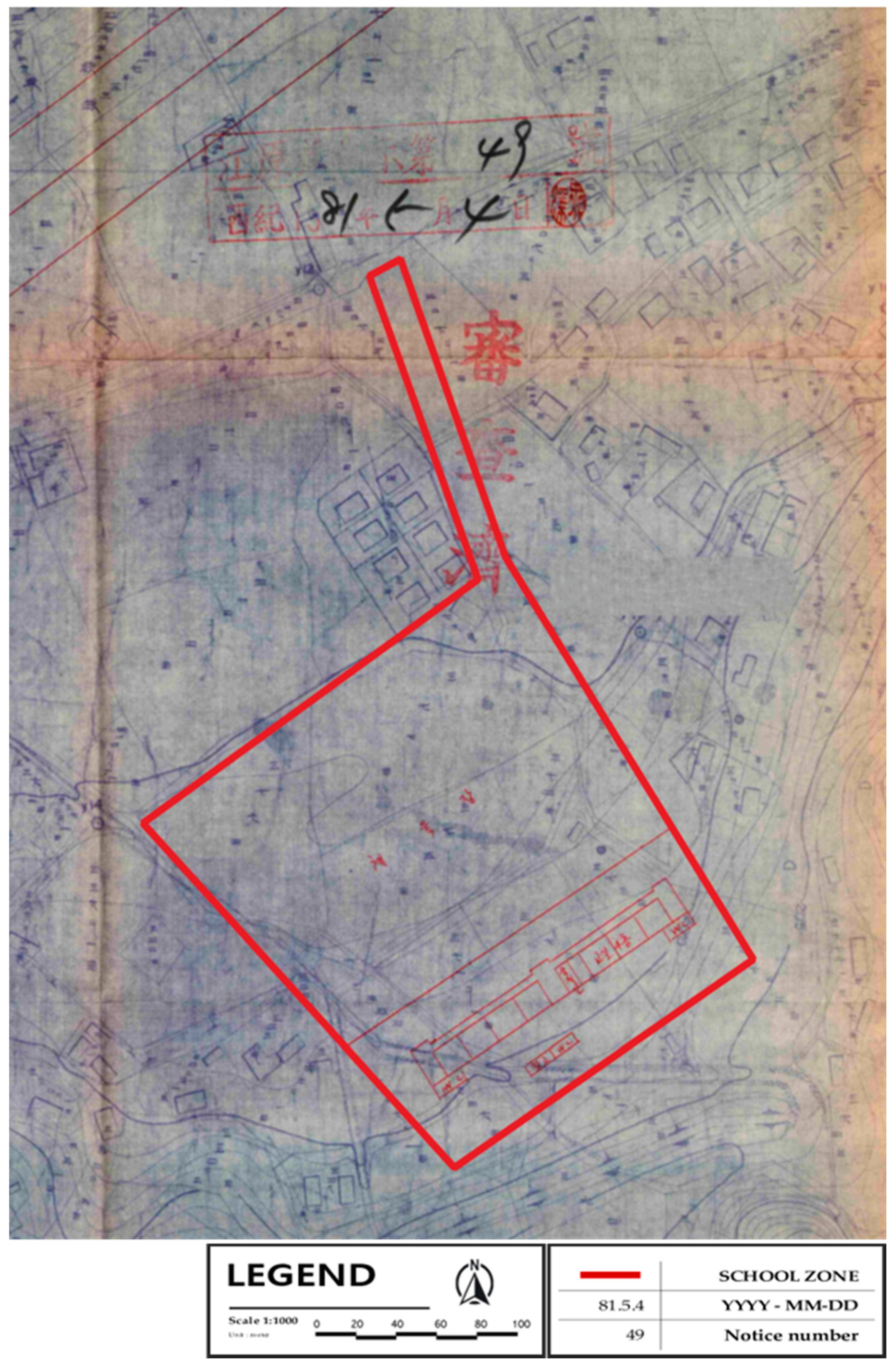
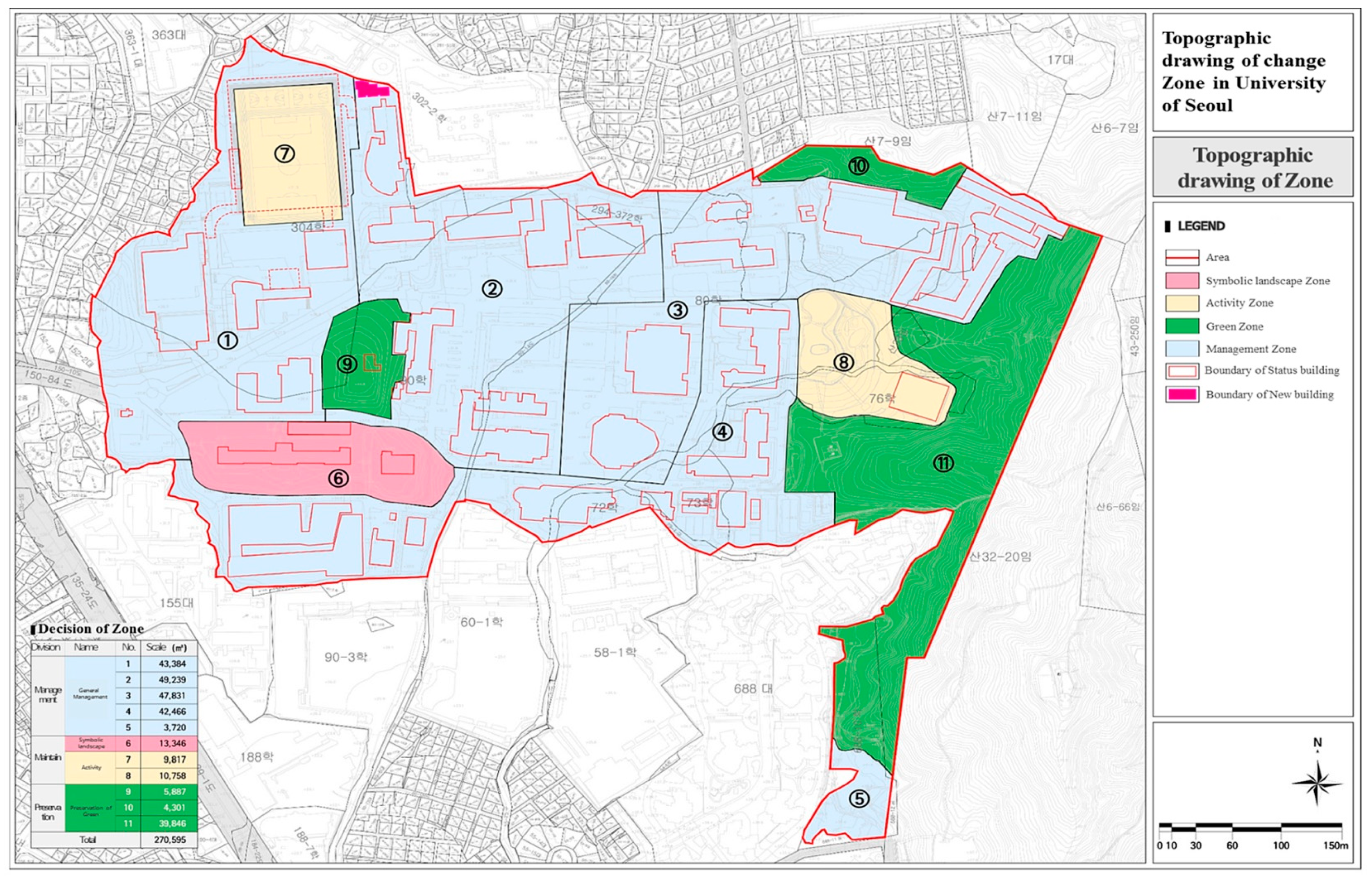
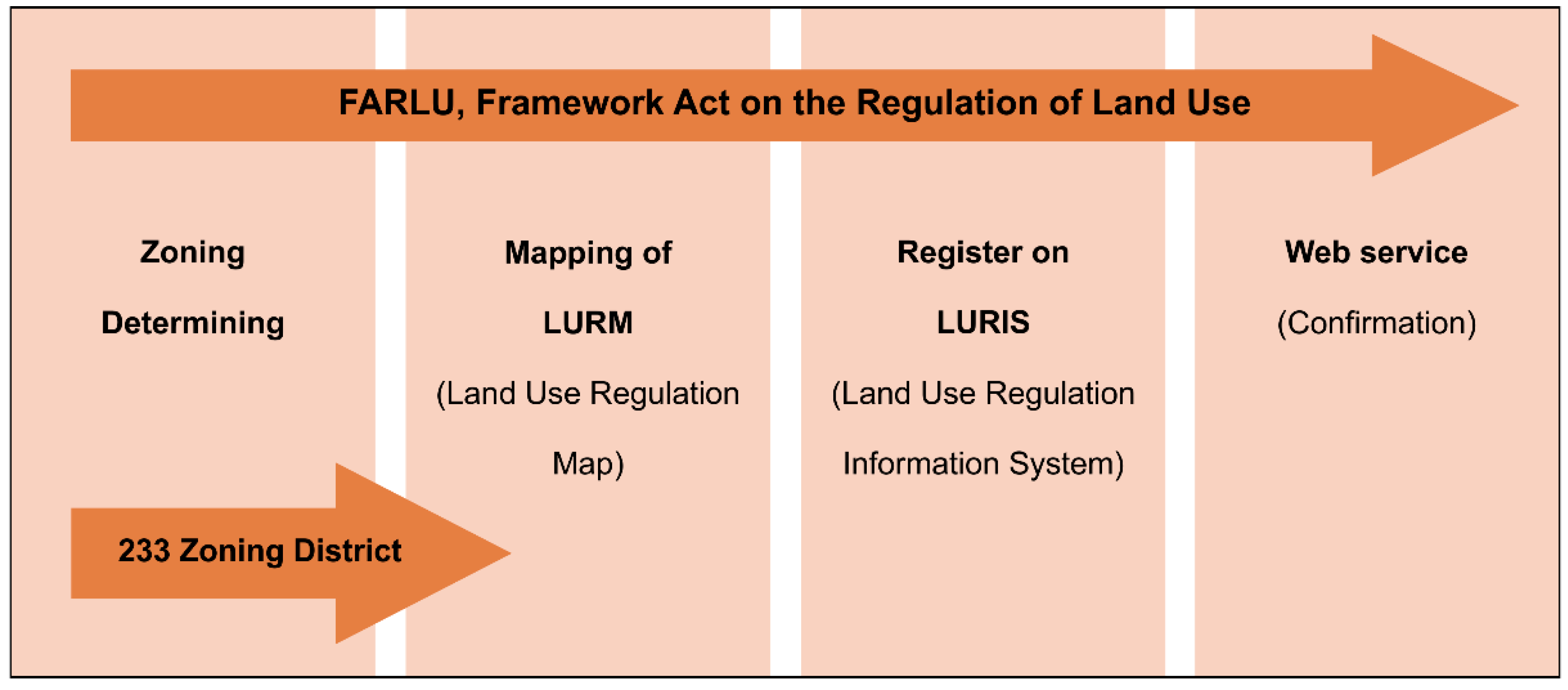
| Zoning | Revised Law | Relevant Government Agency | Acceptance Status |
|---|---|---|---|
| Housing Development Area | Housing Act | Ministry of Land, Infrastructure, and Transport | Partially Accepted |
| Housing Site Development Area | Housing Site Development Promotion Act | Ministry of Land, Infrastructure, and Transport | Accepted |
| Sports Facilities Area | Sports Facilities Construction Act | Ministry of Culture, Sports, and Tourism | Accepted |
| Tourism Zone Area | Tourism Promotion Act | Ministry of Culture, Sports, and Tourism | Accepted |
| Reclamation Project Area | Public Waters Reclamation Law | Ministry of Maritime Affairs and Fisheries | Rejected |
| Railroad Area | Railroad Act | Ministry of Land, Infrastructure, and Transport | Accepted |
| Highway and General Road Area | Road Act | Ministry of Land, Infrastructure, and Transport | Accepted |
Publisher’s Note: MDPI stays neutral with regard to jurisdictional claims in published maps and institutional affiliations. |
© 2021 by the authors. Licensee MDPI, Basel, Switzerland. This article is an open access article distributed under the terms and conditions of the Creative Commons Attribution (CC BY) license (http://creativecommons.org/licenses/by/4.0/).
Share and Cite
Moon, J.-k.; Yoo, S.-b.; Sohn, H.-g.; Cho, Y.-s. Conflicting Maps: How Legal Perspectives Could Minimize Zoning Cancellation in Republic of Korea. Land 2021, 10, 256. https://doi.org/10.3390/land10030256
Moon J-k, Yoo S-b, Sohn H-g, Cho Y-s. Conflicting Maps: How Legal Perspectives Could Minimize Zoning Cancellation in Republic of Korea. Land. 2021; 10(3):256. https://doi.org/10.3390/land10030256
Chicago/Turabian StyleMoon, Jung-kyun, Seon-bong Yoo, Hong-gyoo Sohn, and Yonng-sun Cho. 2021. "Conflicting Maps: How Legal Perspectives Could Minimize Zoning Cancellation in Republic of Korea" Land 10, no. 3: 256. https://doi.org/10.3390/land10030256
APA StyleMoon, J.-k., Yoo, S.-b., Sohn, H.-g., & Cho, Y.-s. (2021). Conflicting Maps: How Legal Perspectives Could Minimize Zoning Cancellation in Republic of Korea. Land, 10(3), 256. https://doi.org/10.3390/land10030256





